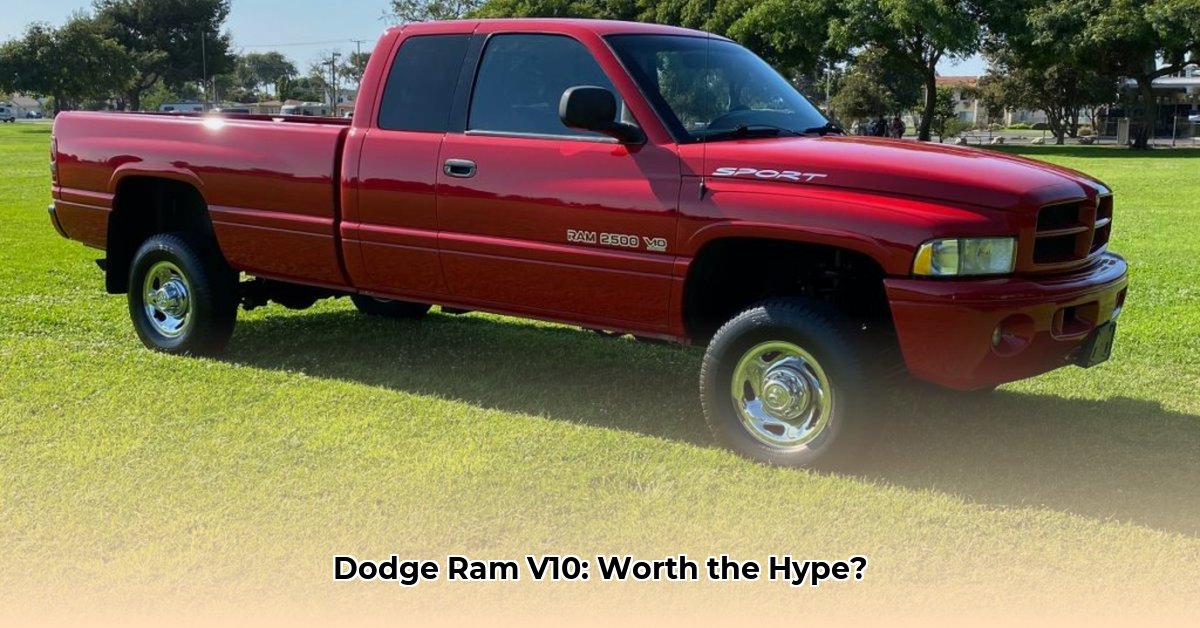
The Dodge Ram V10 engine: a legend among truck enthusiasts. This 8.0-liter gasoline behemoth, producing a substantial 310 horsepower and 450 lb-ft of torque, powered Ram trucks from 1994 to 2003. But this iconic engine wasn't without its quirks. This detailed review explores its strengths and weaknesses, comparing it to the Cummins diesel and offering insights for current and prospective owners.
The Powerhouse: Performance and Towing Prowess
The V10's power was its defining characteristic. It effortlessly hauled heavy loads and conquered challenging terrain, often outperforming diesel competitors in towing capacity for its era. This raw power cemented its reputation as a true workhorse, making it a favorite for demanding applications. But how did this compare to its diesel counterparts? Did the trade-offs outweigh the benefits?
The Price of Power: Fuel Economy and Reliability Challenges
Let's address the elephant in the room: fuel economy. Expect single-digit MPG in heavy towing scenarios, and even on the highway, you'll likely see only 11-13 MPG—a significant drawback by today’s standards. The engine's fuel consumption was a frequent complaint, creating substantial running costs.
Reliability issues also plagued the V10. While a generally sturdy engine, problems such as cracked cylinder heads (resulting in costly repairs), engine hesitation, and catalytic converter failures were common. These issues could be expensive, potentially leading to significant downtime. How did these issues compare to the more famed reliability of the Cummins?
The Great Debate: V10 vs. Cummins
The V10’s powerful performance is undeniable, but how does it stack up against the legendary 5.9L Cummins diesel? While the V10 reigned supreme in raw power and torque, the Cummins excelled in fuel efficiency and longevity, often exceeding 350,000 miles without major overhauls. This highlights the crucial trade-off: untamed power versus fuel efficiency and long-term dependability. The "better" choice depends entirely on individual priorities.
Tuning and Modifications: A Limited Landscape
Modifying the V10 for increased performance isn't straightforward. Its automatic transmission presents limitations, hindering significant power upgrades. While bolt-on parts exist, major power increases risk transmission failure. This contrasts sharply with engines with extensive aftermarket support. The limited modification potential further emphasizes the engine’s inherent design constraints.
The Daily Grind: Owning a V10 Ram
Owning a Dodge Ram V10 is unique. The exhilarating power is countered by the need for substantial budgeting for regular maintenance and potential repairs. Prospective buyers should carefully consider this. Understanding that high-mileage trucks may require significant engine work (rebuild or replacement) is crucial for informed decision-making.
Practical Tips for V10 Owners and Enthusiasts
Here's a brief guide to help you navigate the world of V10 ownership, tailored to different user groups:
| Stakeholder Group | Short-Term Actions | Long-Term Strategies |
|---|---|---|
| V10 Owners | Regular maintenance, fuel system checks, address hesitation | Engine rebuild/replacement (high-mileage), preventative maintenance |
| Aftermarket Companies | Develop fuel-efficiency parts, limited tuning solutions | Invest in transmission upgrades, improved cooling systems |
| Classic Car Enthusiasts | Restoration, parts sourcing, preventative maintenance | Preserving original components, creating a strong community |
Improving Fuel Efficiency: Practical Strategies
The V10’s fuel consumption is a well-known issue. While a significant overhaul isn't feasible, implementing certain strategies can enhance fuel economy:
Key Factors Affecting Fuel Consumption:
- Driving Style: Gentle acceleration and consistent speeds are vital. Aggressive driving significantly reduces MPG.
- Maintenance: Regular oil changes, clean air filters, and properly functioning spark plugs are essential.
- Tire Pressure: Properly inflated tires minimize rolling resistance, improving MPG.
- Towing: Towing drastically reduces fuel economy (6-12 MPG reduction is common).
- Aftermarket Modifications: The effectiveness of aftermarket modifications for improved MPG is largely anecdotal and requires further scrutiny.
Practical Steps for Better MPG:
- Drive Smoothly: Avoid aggressive acceleration and braking.
- Maintain Regularly: Adhere strictly to the recommended maintenance schedule.
- Check Tire Pressure: Ensure tires are properly inflated.
- Consider Tire Upgrades (Diameter over Width): For replacements, focus on diameter for potential improvements.
- Limit Heavy Towing: Avoid heavy towing if possible.
Conclusion: A Powerful Legacy with Trade-offs
The Dodge Ram V10 holds a special place in automotive history. Its unmatched power and torque made it a legend in its time. However, its significant fuel consumption and maintenance requirements are critical considerations. Understanding both the strengths and limitations of this powerful engine is vital for anyone contemplating ownership or simply appreciating its unique place in automotive history.